- New Products
- Exclusive Gear
- Bushcraft Gear
- Containers
- Cooking
- Fire
- First Aid
- Food Gathering
- Knives & Tools
- Knife Collectors Corner
- Light
- Logo Gear
- Misc. Items
- Navigation
- Packs, Pouches & Bags
- Personal Care
- Repair Gear
- Shelter & Protection
- Signaling
- Urban Survival
- Water
- Writing Gear
- John's Books
- Bargain Bin
Recharging On The Go
Whether you are in an urban, suburban, or wilderness environment, you probably carry some form of electronic devices or equipment. If you carry items such as a Smartphone, a GPS, a camera, flashlight, or a small tablet, as part of your everyday carry (EDC), or as part of your get-home bag, bug-out bag, evacuation kit, or wilderness pack, you should have some way to recharge those devices. Some of your items may use batteries, which will need to be recharged as well. The size and type of charger will depend on whether it is a daily trip, or extended excursion. The longer you are gone, the more reserve power you will require. Of course there are various types of devices available for this purpose. I will identify some that are quality products, perform as intended, and have worked well for my purposes.
 This shows me hiking with a solar panel attached to the back of my pack charging a flashlight in the pack.
This shows me hiking with a solar panel attached to the back of my pack charging a flashlight in the pack.
PORTABLE CHARGERS
For my EDC (Everyday Carry) I carry an Anker 2nd Gen Astro Mini, 3200 mAh lipstick sized portable charger which is also an external battery power bank. It measures only 3.7" long by 0.9" in diameter, and weighs only 3 ounces. I like it because it gives you a small charging station in the palm of your hand. You can recharge it using a USB cable, from a standard USB wall charger, or from a 12 volt adapter for your vehicle (which we will discuss later).
The Anker 2nd Gen Astro Mini has a Power IQ which detects your device and its amp-adjustment technology intelligently identifies your device and delivers its fastest possible charge. It will add over a full charge to an iPhone and other Smartphone's, and almost one full charge to a Galaxy S5.
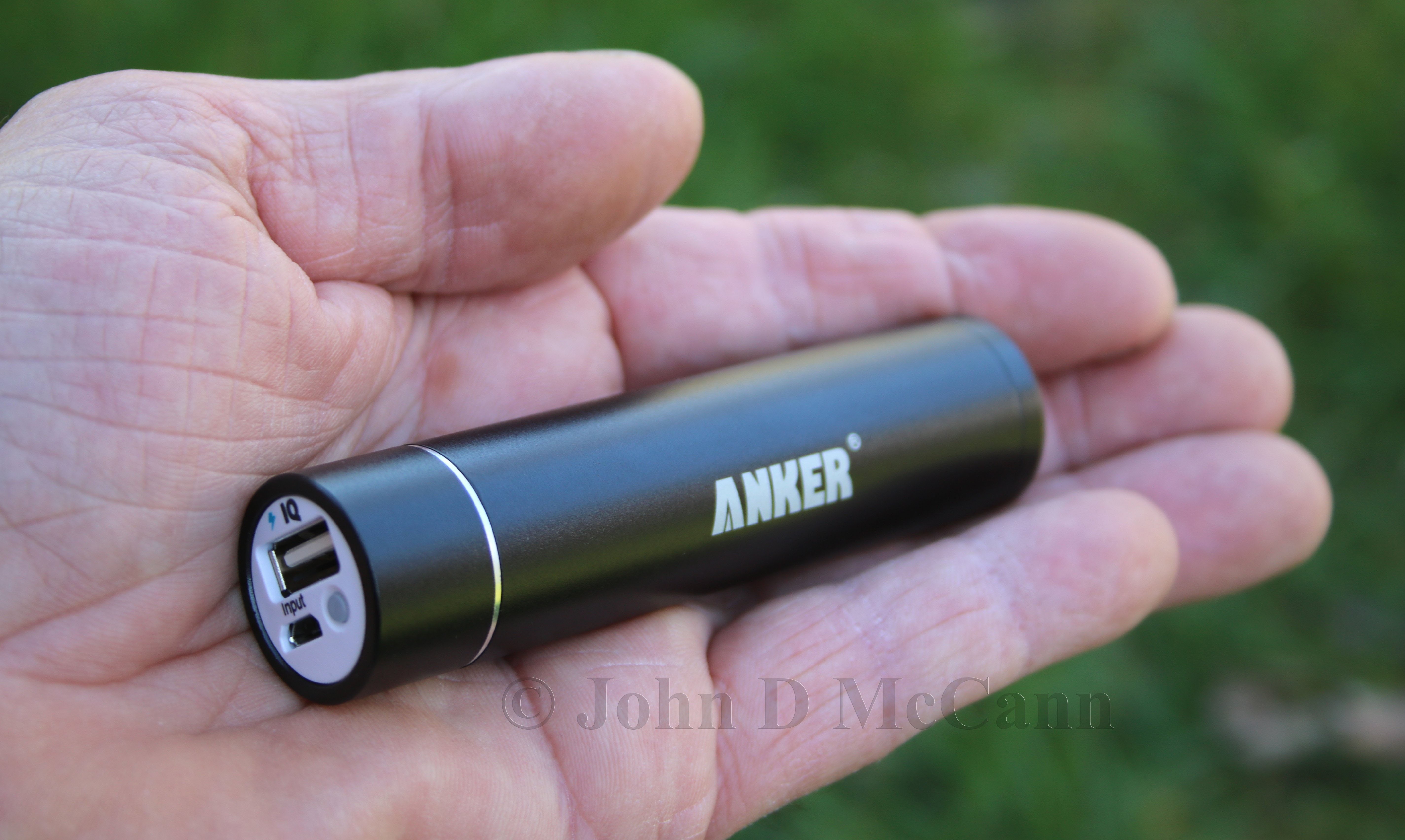 As you can see, the Anker 2nd Gen Astro Mini fits in the palm of your hand. You can see the Power IQ USB output and the micro input for charging on the left.
As you can see, the Anker 2nd Gen Astro Mini fits in the palm of your hand. You can see the Power IQ USB output and the micro input for charging on the left.
One thing to remember when carrying a small portable charger as part of your EDC, you need a connector cable in order to attach your device to the charger. For the Anker 2nd Gen Astro Mini, I like to carry it in a small belt pouch next to my phone. I wanted a connector cord that was the same length as the Anker Mini, I purchased a four inch Anker cable with a USB on one end and a lightning connector on the other, for use with my iPhone. It is the same length as the Anker 2nd Gen Astro Mini and it fits nicely in the belt pouch with the Anker Mini and is always with me for charging my phone, if needed.
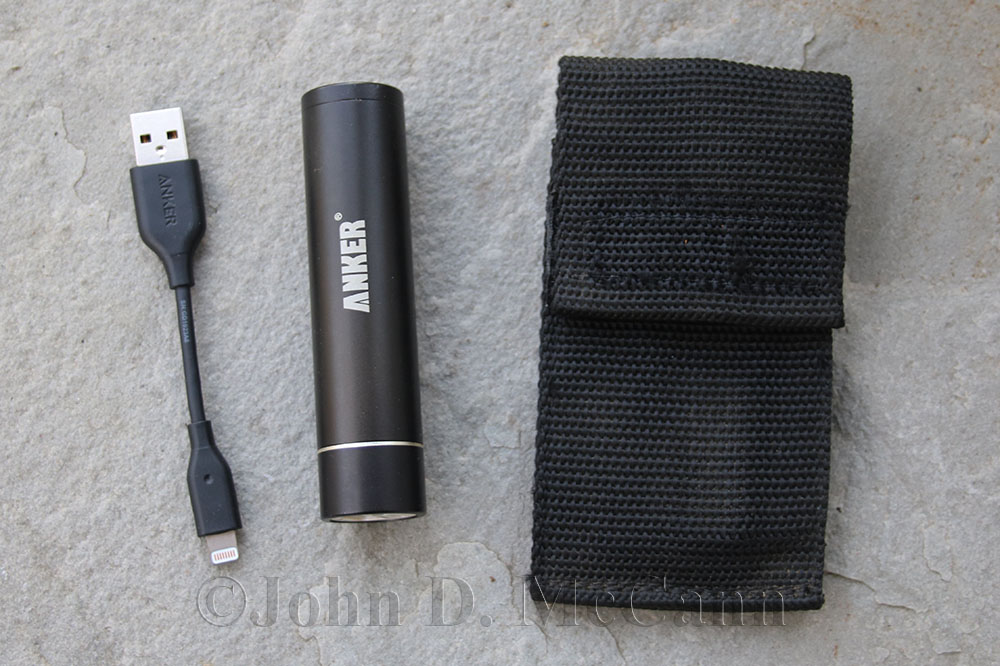 This shows the four inch connector cable on the left, the Anker Mini in the center, and the belt pouch on the right.
This shows the four inch connector cable on the left, the Anker Mini in the center, and the belt pouch on the right.
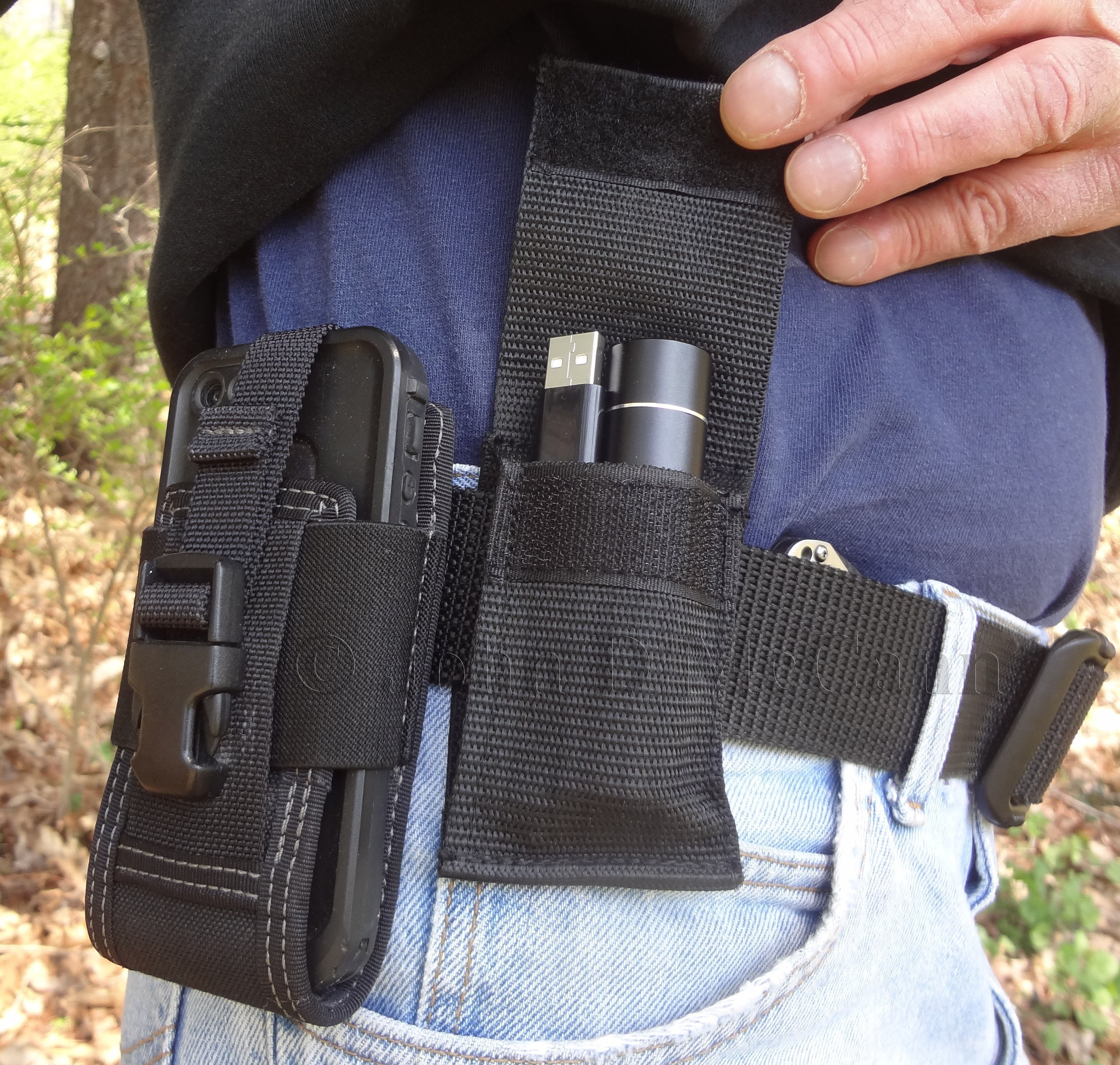 The belt pouch holding the Anker Mini with modified connector cord rides on the belt next to my iPhone.
The belt pouch holding the Anker Mini with modified connector cord rides on the belt next to my iPhone.
If the Anker 2nd Gen Astro Mini will not provide you with enough recharges, or you carry more than just a Smartphone, Anker offers a larger device, which I carry in my evacuation kit. It is called the Anker 2nd Generation E4 External Battery that provides 13000mAh yet measures only 5-7/8" x 2-1/2" x 3/4" and weighs only 10.2 ounces. It provides an incredible amount of backup power to recharge various devices, yet is small enough to carry in a bag. It also has the Power IQ and two USB outputs for charging. It can be charged using any USB charger. I have a standard USB cable and an Apple Lightning to USB cable. This allows me to also charge my iPhone, or even the iPad if it was included in an evacuation. I also use it to charge my OLight S20R Baton flashlight which I carry as part of my EDC.
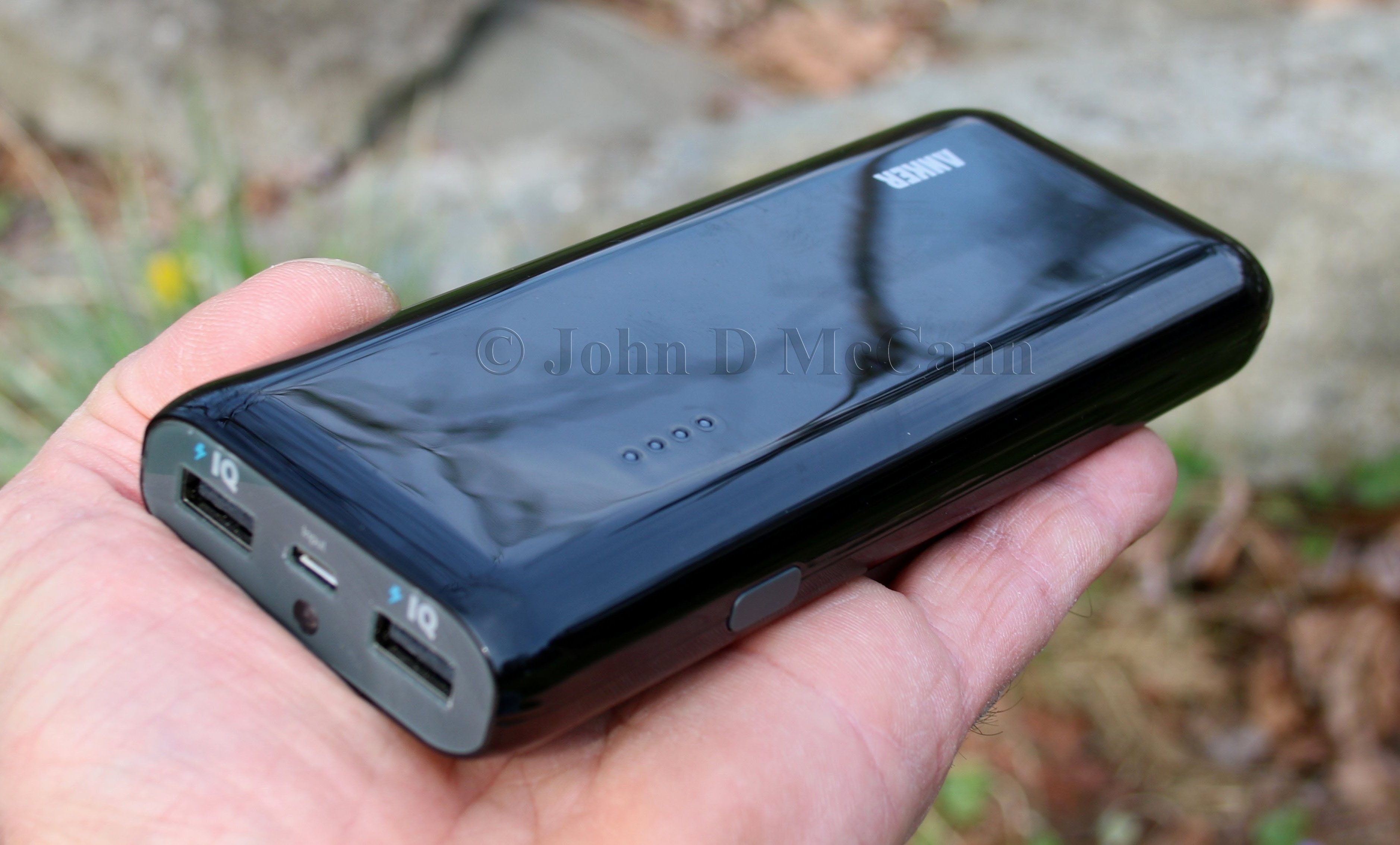 This shows the size of the Anker 2nd Gen E4 External Battery, which has two USB outputs for charging two
This shows the size of the Anker 2nd Gen E4 External Battery, which has two USB outputs for charging two
devices at the same time.
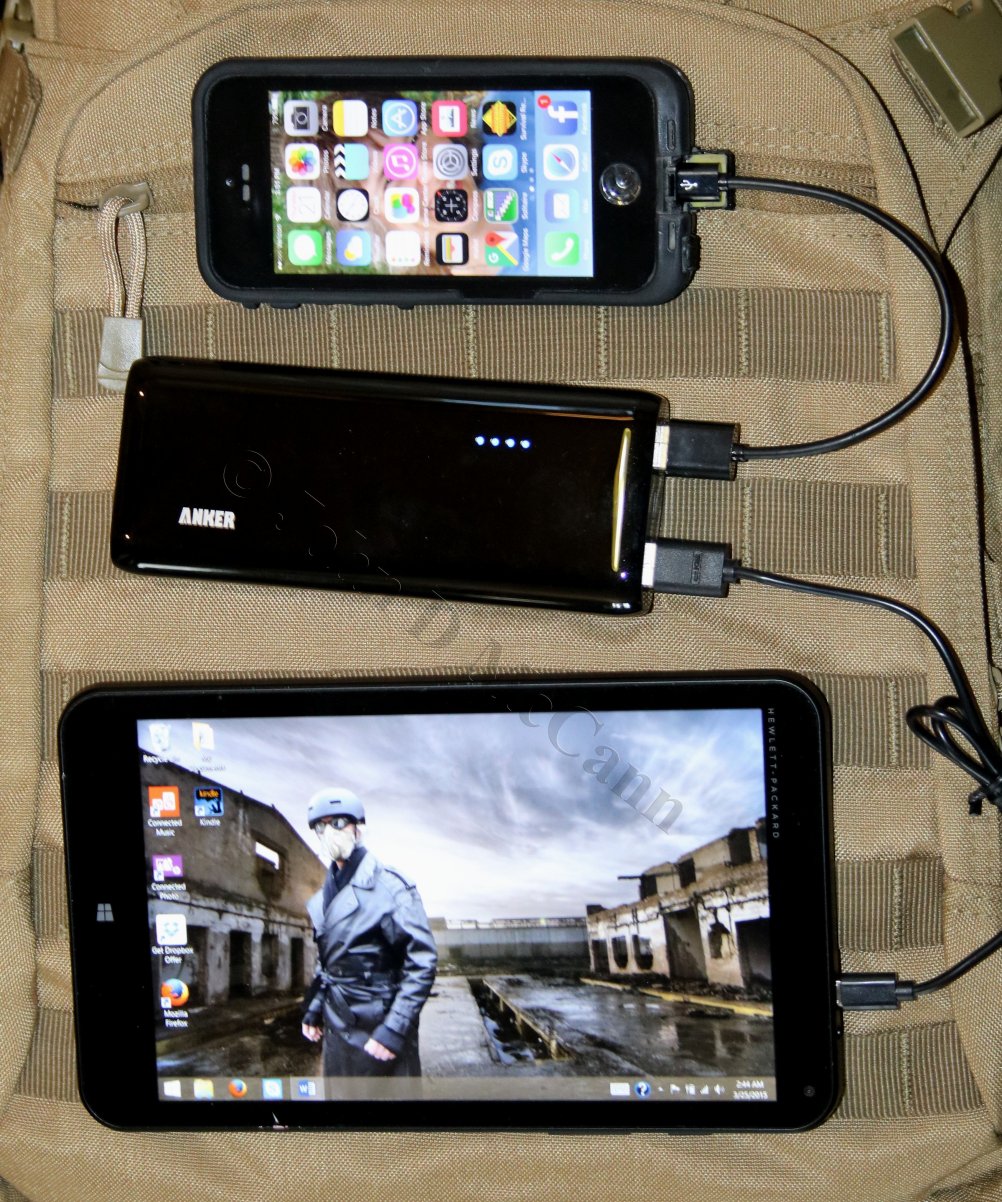 In this photo, I use the Anker 2nd Gen E4 to charge both my iPhone and a small
In this photo, I use the Anker 2nd Gen E4 to charge both my iPhone and a small
HP Stream 8 tablet, which is carried in my evacuation kit in order to read the information
on my IronKey flash drive, which securely holds emergency information.
The next item is a very handy device because in offers various options. It is called the GoalZero Guide 10 Plus Recharger. The Guide10 Plus Recharger is a go-anywhere, rechargeable battery pack that keeps your handheld gear going strong. It charges both AA and AAA batteries from the from a USB port or the sun, using any of the GoalZero solar panels (which I will discuss later). You can then directly charge a Smartphone in 1 hour. The built-in LED light runs for 150+ hours per charge, providing you with an extra flashlight. Of course, it can also be used just to charge AA or AAA batteries for use in devices such as a handheld GPS, headlamp, flashlight, or other gear that runs off batteries.
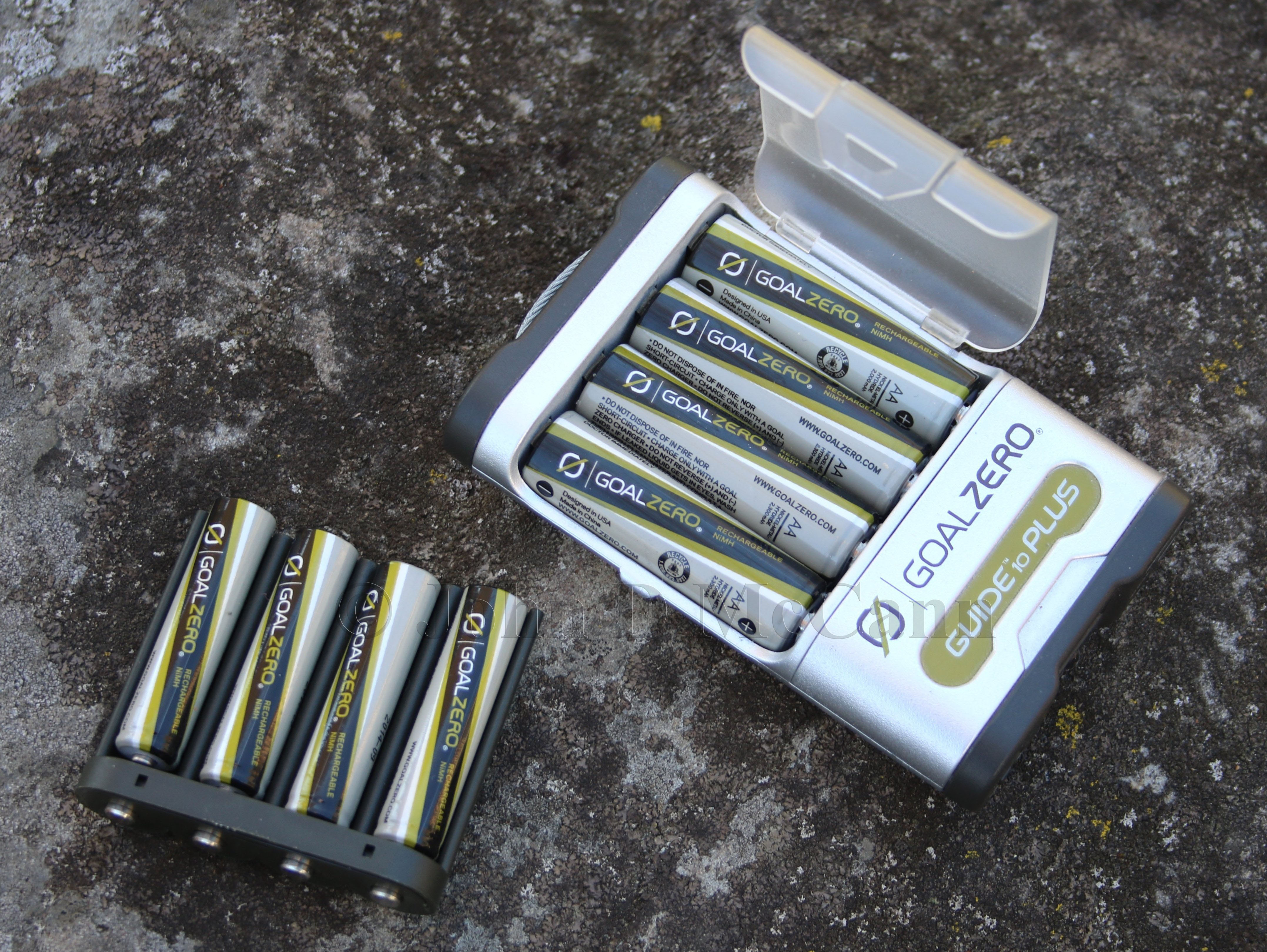 This photo shows the GoalZero Guide 10 Plus Recharger with AA batteries inside. The lower left shows the
This photo shows the GoalZero Guide 10 Plus Recharger with AA batteries inside. The lower left shows the
AAA battery adapter that can be inserted into the Guide 10 Plus.
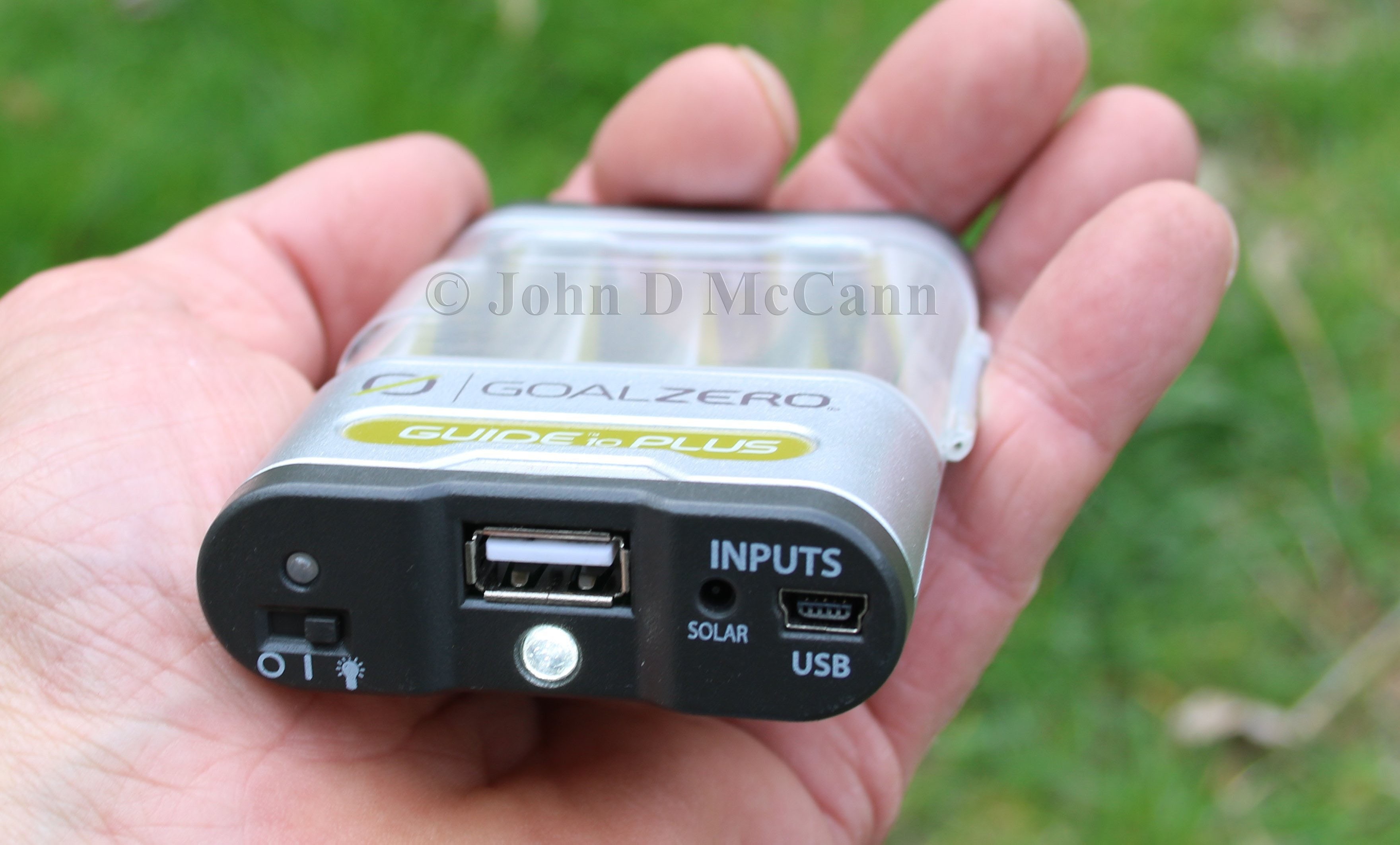 This shows the front of the GoalZero Guide 10 Plus recharger with the LED flashlight on. You can see that the
This shows the front of the GoalZero Guide 10 Plus recharger with the LED flashlight on. You can see that the
Guide 10 fits in the palm of your hand.
USB RECHARGEABLE FLASHLIGHTS
There are also flashlights available that can be recharged by USB. Some are even combination units that are a flashlight on one end and are a USB recharger on the other. The advantage of this type of flashlight is they can be left plugged in to a USB charger, or a USB port on a computer, etc., so they are ready when you need them. Most portable solar panels also have a five volt USB output for charging in the field.
The first USB chargeable flash light I will discuss is the Powerbank 2600 mAh flashlight, which has a bright, dim, and strobe setting. What is unique about this light is it is also a portable charger, like the Anker 2nd Gen Astro Mini, discussed previously. The rear of the flashlight looks just like the Anker and will charge smartphones and USB powered devices. I like multi-functional items and this is certainly one.
The next USB flashlight I like because of its size is the UST Jolt Mini USB LED Light. The UST Jolt Flashlight a handy rechargeable light you can take on the go. It recharges in any USB output device such as PCs and USB charger or car adapters. A built-in clip attaches just about anywhere you need extra light, such as a key ring, zipper, or backpack. It can be recharged over 500 times and never needs batteries. It has a bright 25 lumen LED with steady ON and FLASHING modes, with an easy twist on/off switch. Simply plug and recharge at any USB port and a red LED charging indicator lets you know it is charging. It is water-resistant when securely closed and is available in Black or Orange.
The third flashlight I will discuss is an extremely bright light and makes a great EDC (Everyday Carry) light. It is called the Olight S20R Baton and is an extremely compact and powerful LED flashlight with an intelligent multi-function side switch. It is made from hard-anodized aircraft-grade aluminum, and uses a top-of-the-line CREE XM-L2 LED putting out a retina-scorching 550 lumens. It has four different power settings and a strobe mode to suit your specific needs. It uses rechargeable lithium-ion batteries and has a compact Micro-USB charging dock so you don’t have to worry about bulky chargers or special cables. With its dual purpose magnetic tailcap, you can use the S20R as a hands-free worklight, and attach it securely to the included charging base. Whether you’re changing a tire at night at the side of the road, defending yourself in a dark alleyway, outfitting your bug-out bag, or trekking through the woods, this is a very handy flashlight for all your needs. It should be noted that the Olight S20R has been replaced by the Olight S30R Baton III.
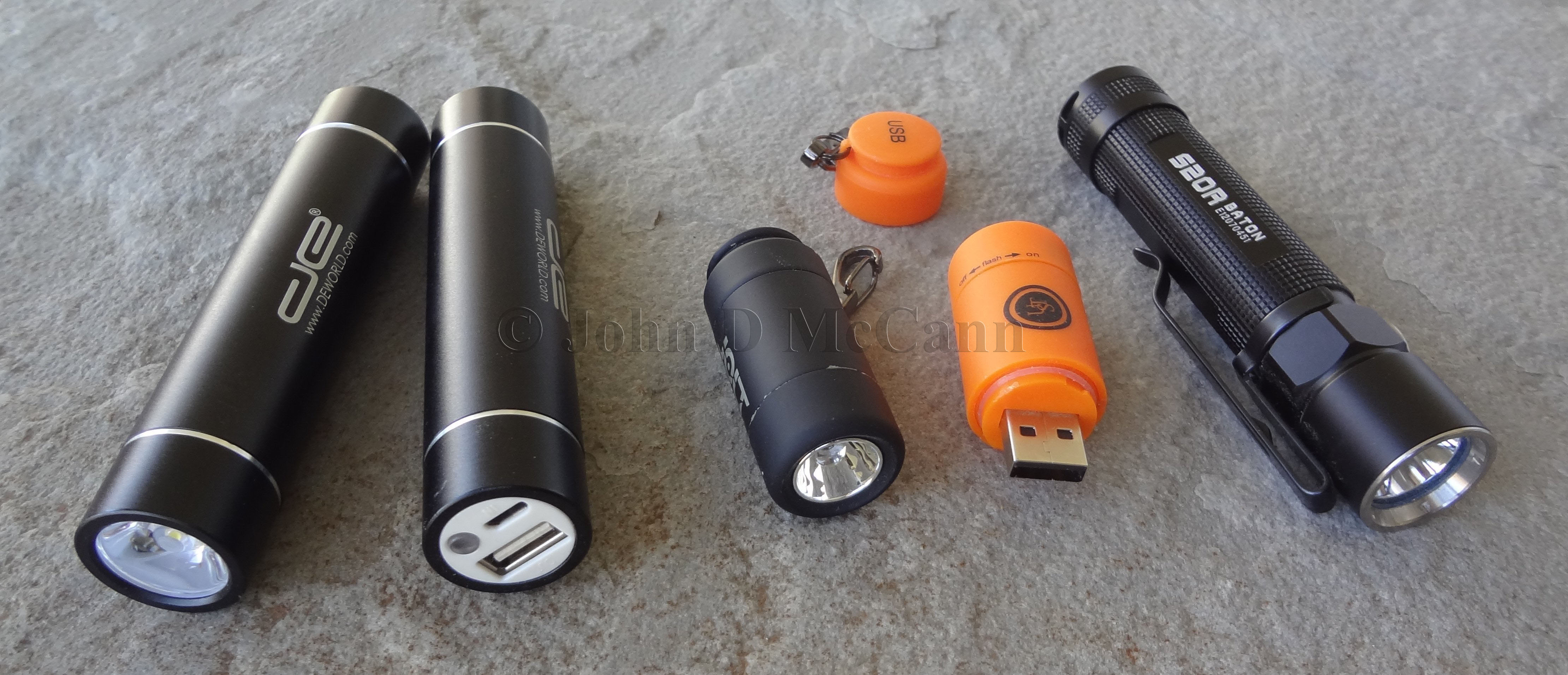 The left shows both the front and rear view of the Powerbank 2600 mAh flashlight. The center shows both the
The left shows both the front and rear view of the Powerbank 2600 mAh flashlight. The center shows both the
front and rear view of the UST Jolt™ USB Mini Light. The right shows the Olight S20R Baton flashlight.
Another handy USB light is the GoalZero Luna Light. I like this light as it uses LED's and provide for extra illumination in an emergency situation. It runs great off any of the Anker portable chargers or the Guide 10 Plus charger discussed above, or any other USB output.
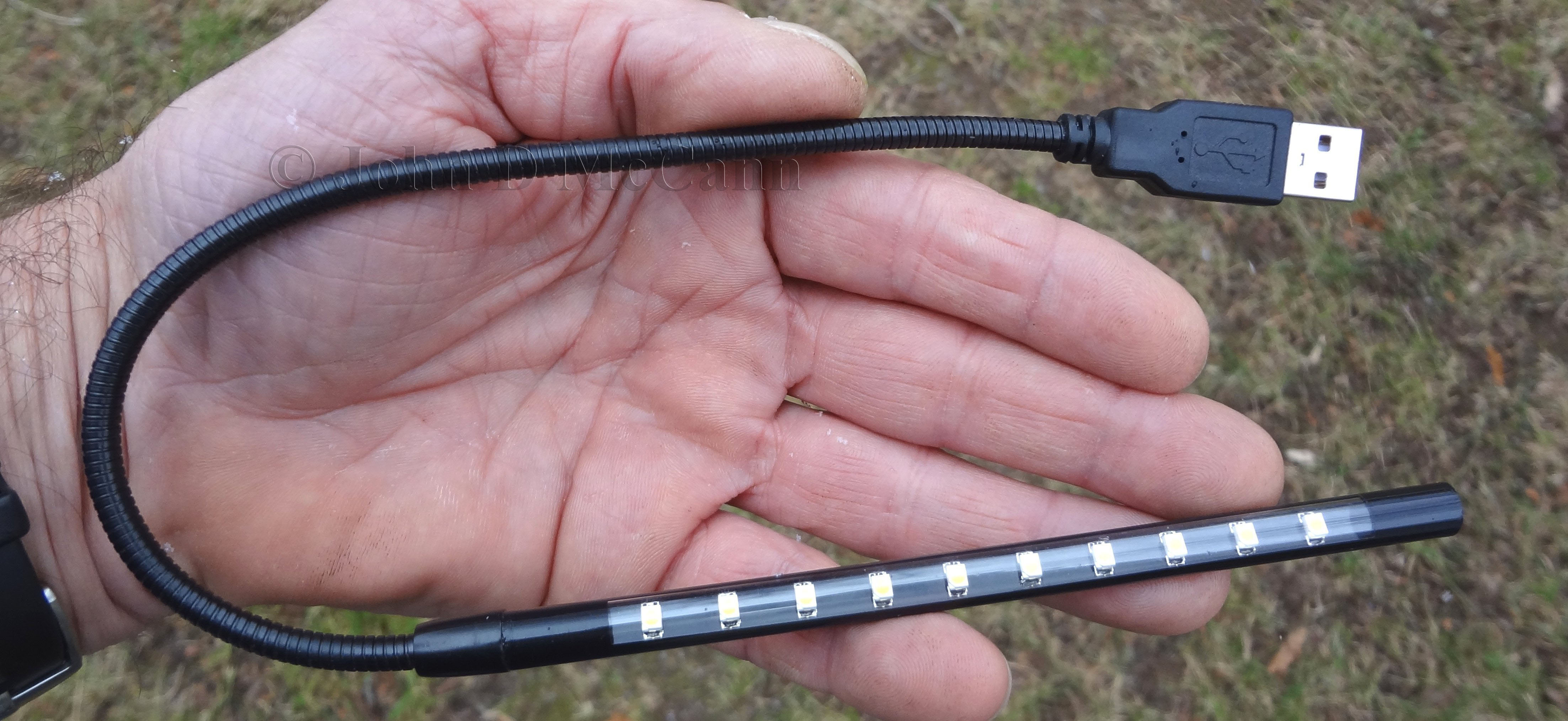 This shows the size of the LED Luna light that plugs into and is powered by any USB port.
This shows the size of the LED Luna light that plugs into and is powered by any USB port.
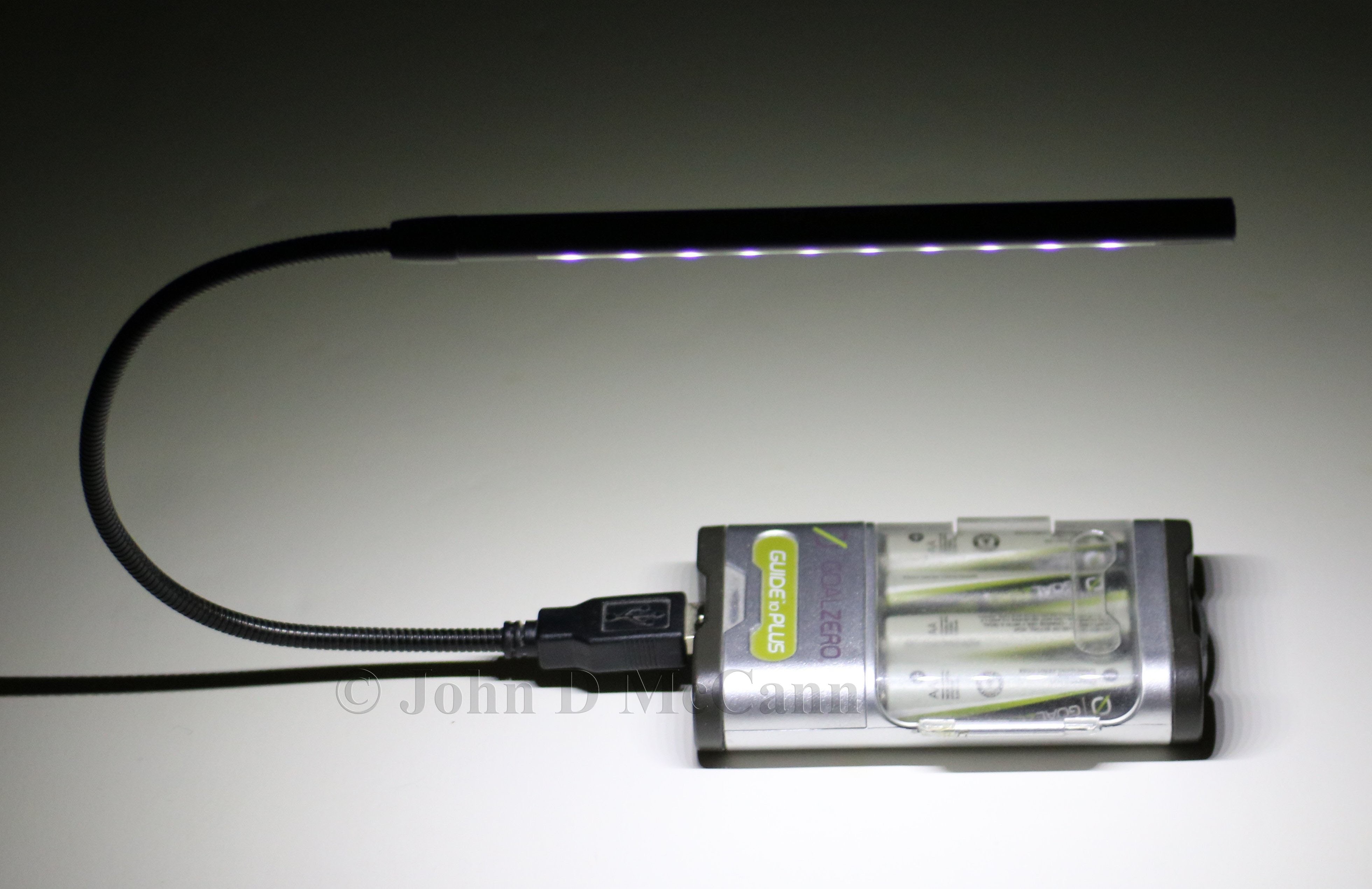 The Luna Light being powered off the USB output on the front of the Guide 10 Plus.
The Luna Light being powered off the USB output on the front of the Guide 10 Plus.
VEHICLE CHARGING
If you travel daily by personal vehicle, then you will want a way to recharge your devices in the vehicle. Some of your newer model vehicles have a USB power output, but most still do not. There are various types of 12 Volt car chargers that plug into the vehicle's accessory outlet. They offer both single and double USB outputs. You simply plug them into your accessory outlet and plug your USB cable into them.
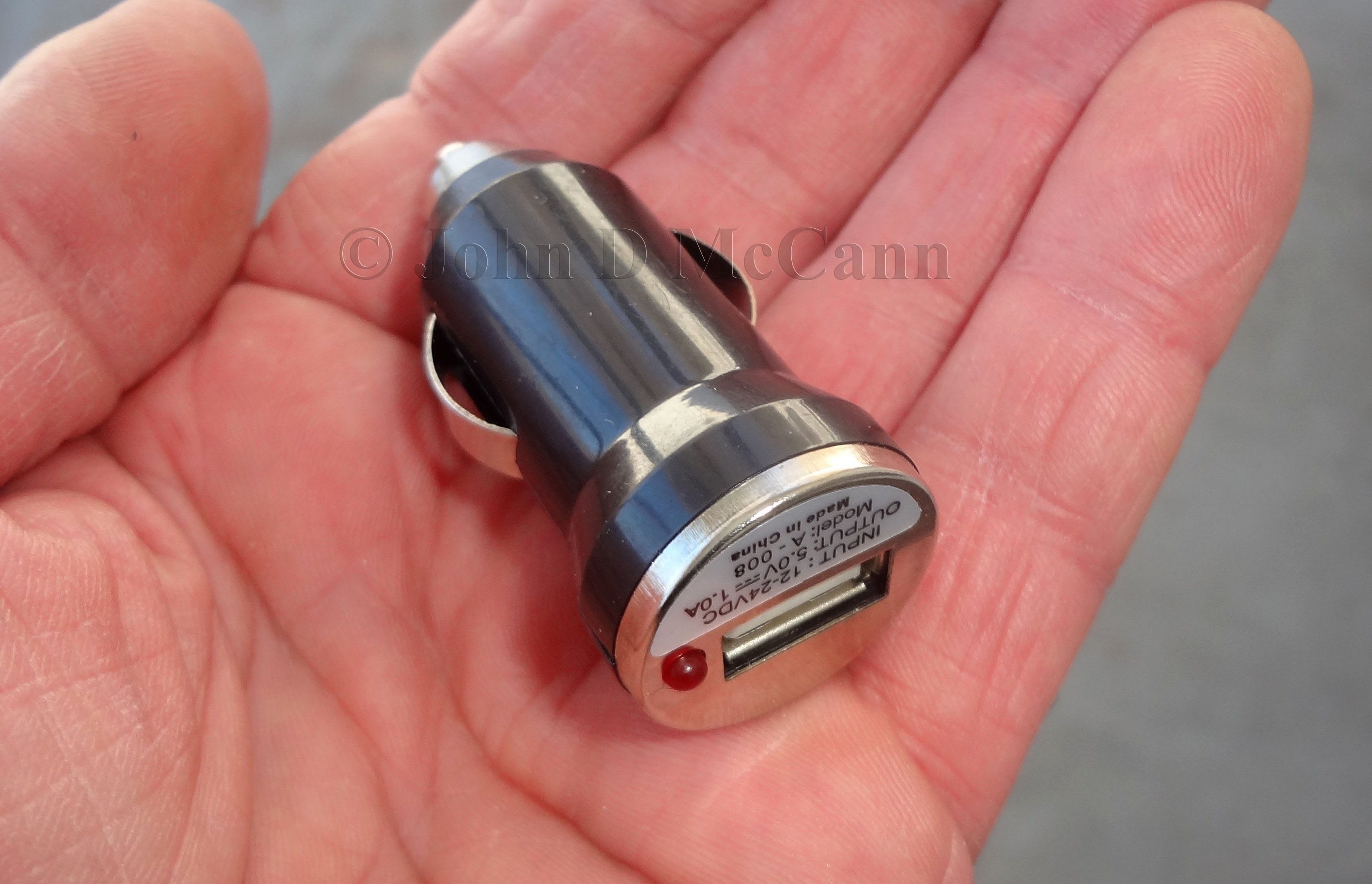 This shows a simple 12 Volt to USB adapter for your vehicle's accessory outlet offering a single USB output. This
This shows a simple 12 Volt to USB adapter for your vehicle's accessory outlet offering a single USB output. This
can be used to charge your devices, or to keep your portable chargers in full charge for later use. They are also
available with two USB outputs.
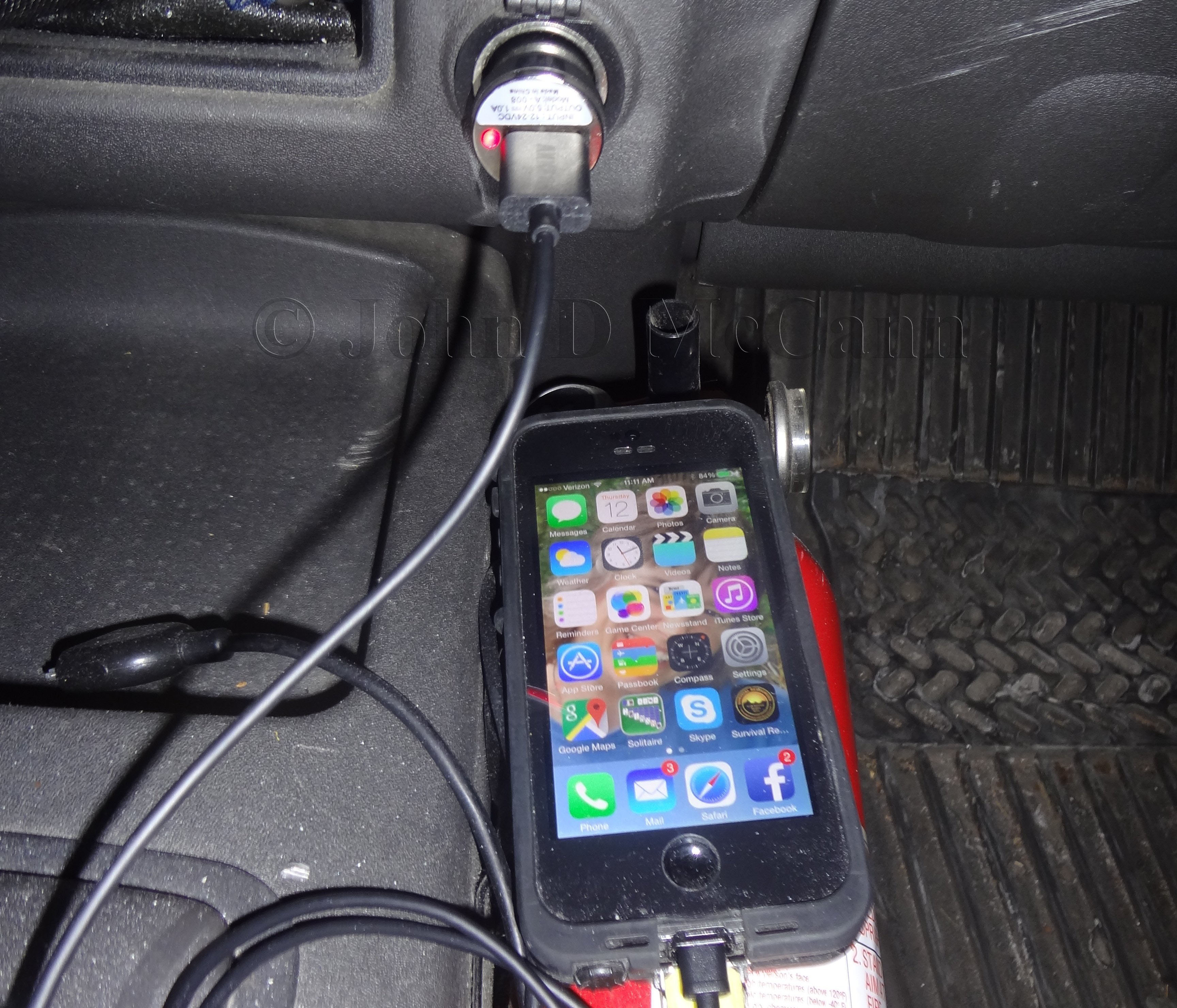 This shows me charging my iPhone with the 12 Volt USB adapter from the accessory
This shows me charging my iPhone with the 12 Volt USB adapter from the accessory
outlet in his truck.
If you are in an extended type of emergency or bug-out situation, where you might not be able to get to electrical power, or if the power is out, you might want to carry a 12 Volt outlet that has alligator clips on it. This can be used if you are able to access the battery of an abandoned vehicle, or other 12 volt battery. You simply connect the outlet directly to the battery and insert your 12 Volt to USB adapter to charge your device.
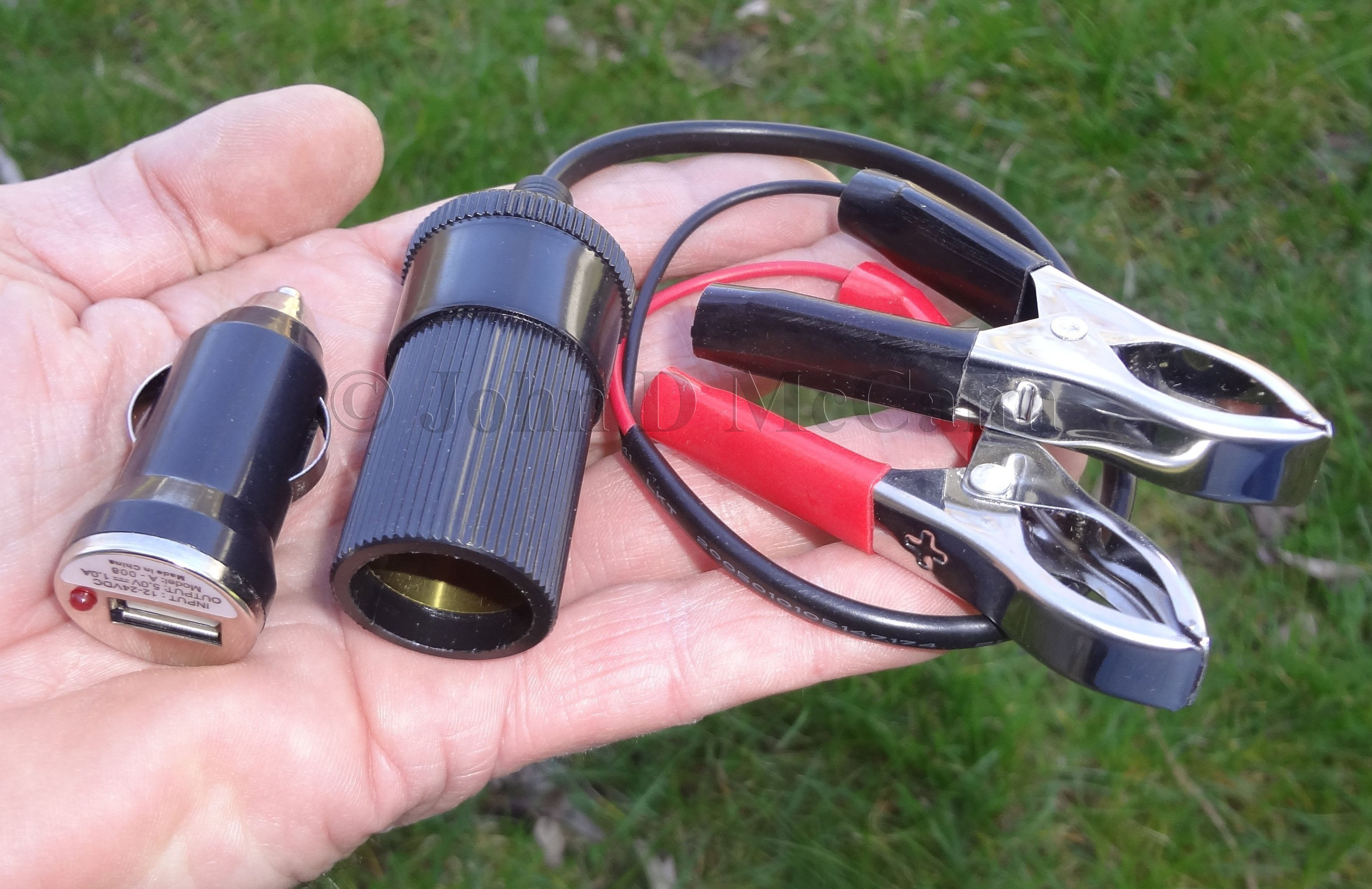 This shows a small 12 Volt outlet with alligator clips and a 12 Volt to USB adapter. I store the
This shows a small 12 Volt outlet with alligator clips and a 12 Volt to USB adapter. I store the
adapter inside the outlet to reduce its size for storage.
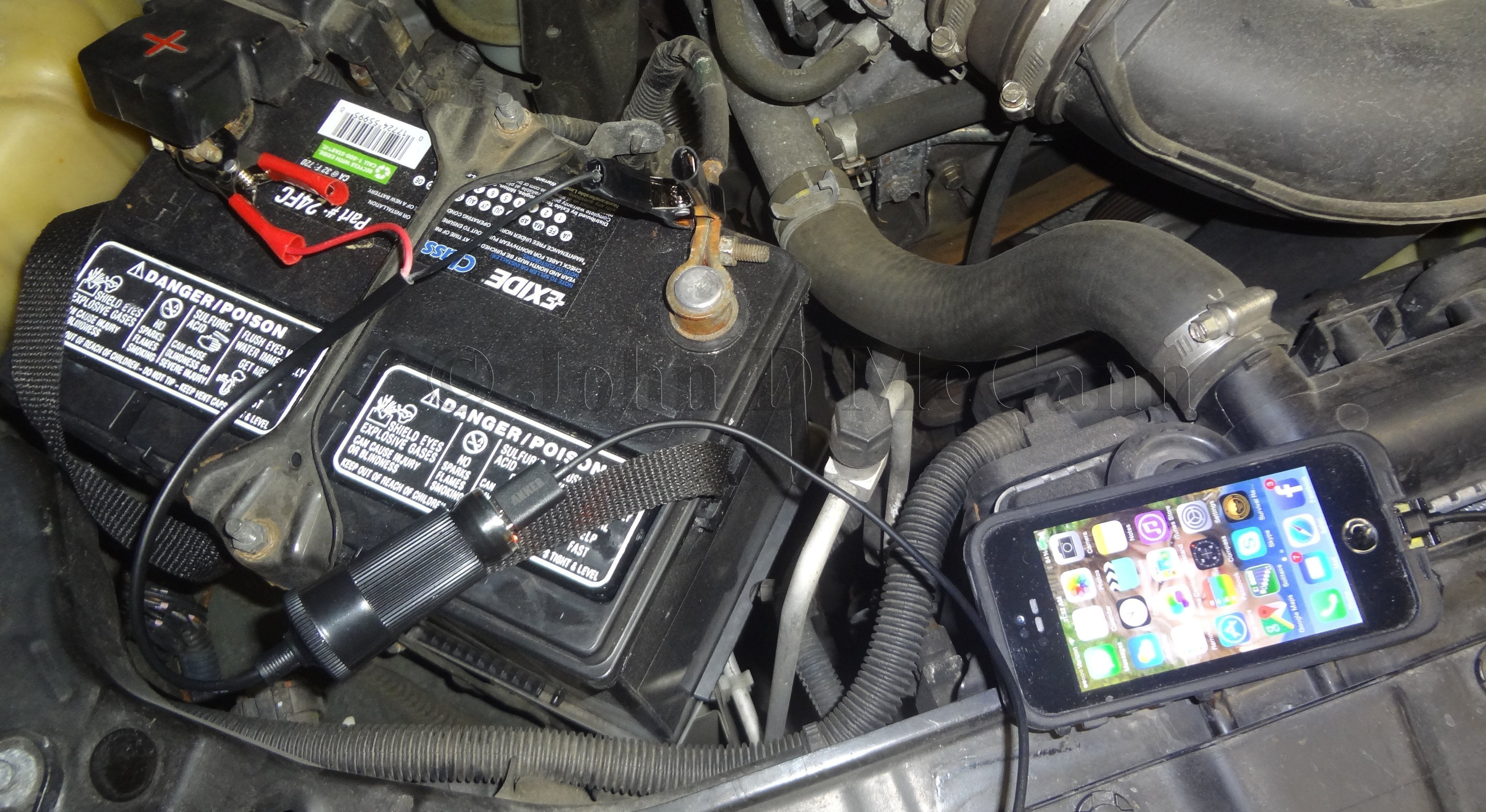 This shows my iPhone being charged directly from a vehicle battery using the 12 Volt outlet and USB
This shows my iPhone being charged directly from a vehicle battery using the 12 Volt outlet and USB
adapter discussed in the article.
PORTABLE SOLAR PANELS
For a bug-out or evacuation kit, or an extended camping situation, you might need the ability to recharge for a longer period of time. If normal power is not available, portable solar might be an option. There are various manufacturers of portable solar panels, and although some of them work well, many only offer a five volt USB output. I have been using GoalZero products for many years and prefer them because they provide various output voltages to include a five volt USB and 12 volt.
The GoalZero Guide 10 Plus Recharger, discussed earlier, is also offered as a solar kit including a small foldable solar panel. The included Nomad 7 solar panel provides you with an ultra-compact yet powerful solar panel that enables you to charge your handheld devices directly from its USB and 12 Volt DC charging ports. It collects 7 Watts of power from the sun, is foldable, has a rugged design, and is weather resistant. The Nomad 7 will directly charge most USB and 12 volt devices (not tablets), and it can be chained together with other panels for increased collection. Ports provided are a 5 volt USB Port, a regulated 15 volt (for twelve volt requirements), a regulated 6.5 volt Mini Solar Port (used to charge the Guide 10 Plus Recharger), and an input for chaining additional panels in line with this one. The Nomad 7 Solar Panel type is Monocrystalline.
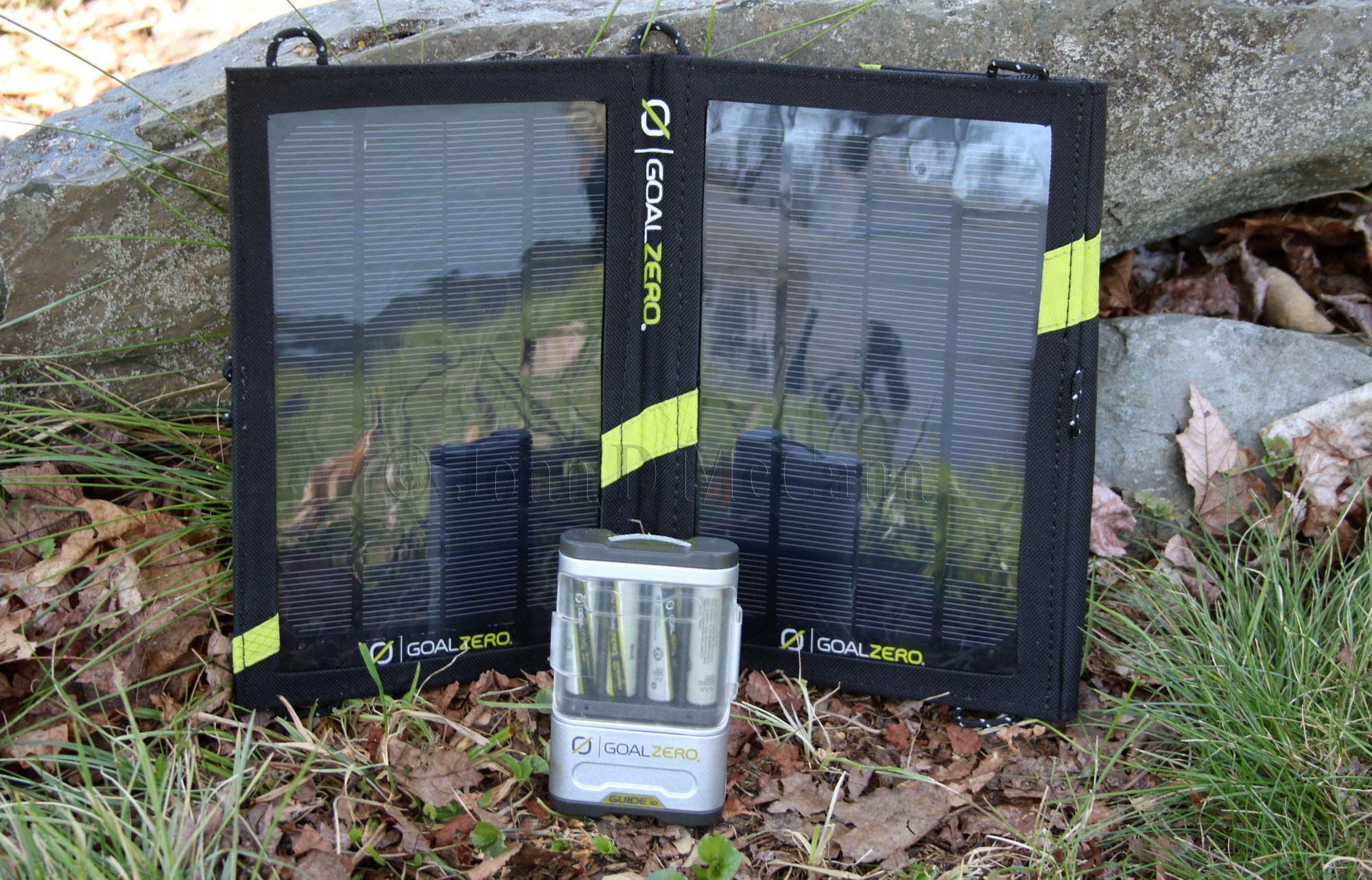 This shows the Nomad 7 portable solar panel with the Guide 10 Plus Recharger.
This shows the Nomad 7 portable solar panel with the Guide 10 Plus Recharger.
I carry the Guide10 Plus Solar Kit as part of my evacuation kit which is normally kept in my vehicle. I include the Anker 2nd Gen E4 external power pack as there is room in the zippered net pouch which is attached to the Nomad 7 solar panel. Together, it provides me a lot of recharging ability as well as various other options.
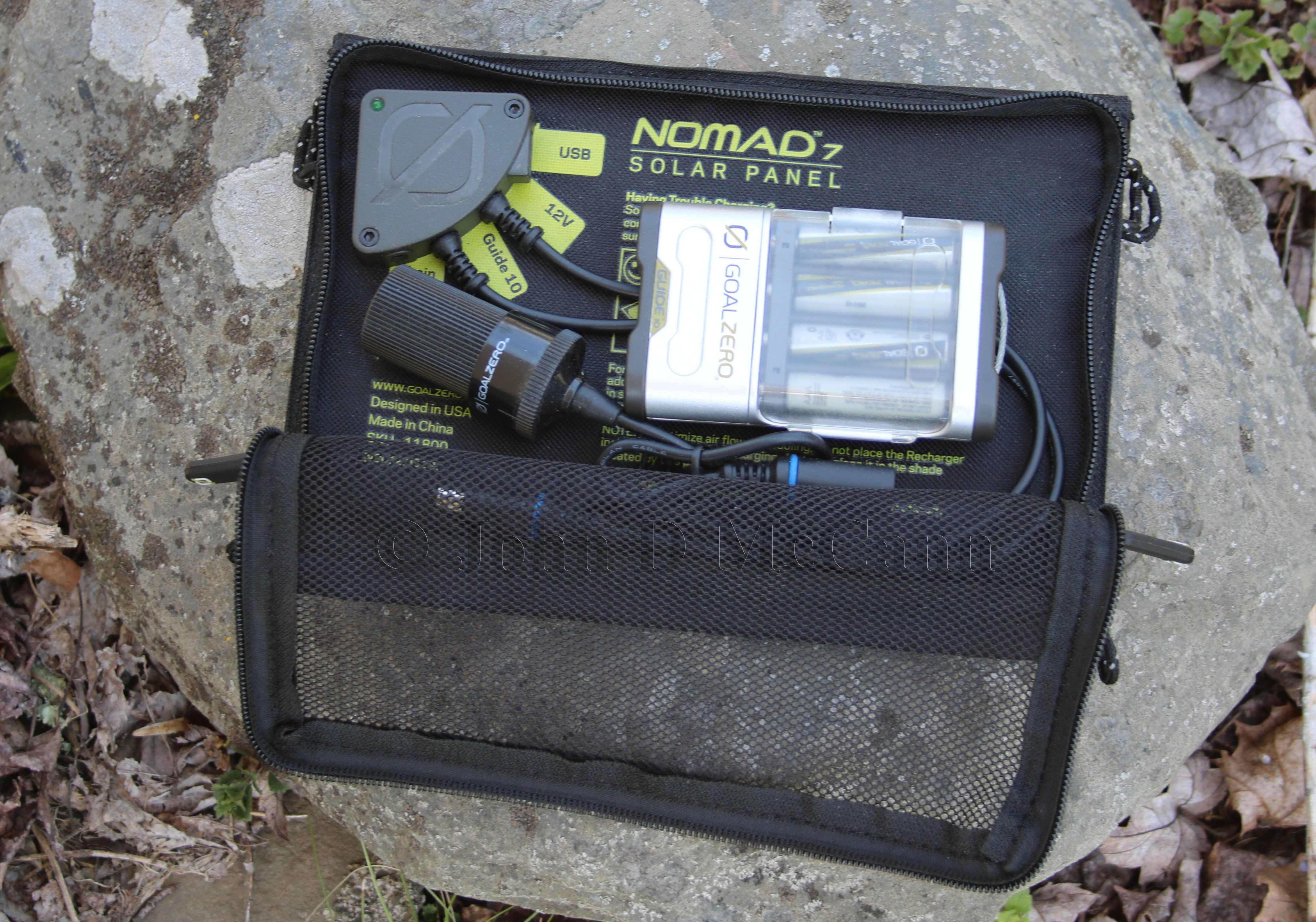 This shows the zippered panel on the back of the Nomad 7 open showing the Guide 10 Plus and array
This shows the zippered panel on the back of the Nomad 7 open showing the Guide 10 Plus and array
of outputs at the top left.
If you are interested in a larger system that provides more power I recommend the GoalZero Sherpa 50 Solar Recharging Kit. Although larger and heavier than the Guide 10 Plus kit, if you have the room it can be a real asset.
The GoalZero Sherpa 50 Recharger (available with or without an inverter) is an ultra-portable power supply to keep laptops and tablets, and other electronic devices charged up anywhere you go. Being it has a 12 volt output as well as a 5 volt USB output, you can even use it to run a 12 volt television panel, as well as other 12V devices. It also has a 19 volt laptop output with charging cable. Offering the various voltage outputs, the Sherpa 50 offers versatility not found on other power supplies. With the addition of the AC inverter the capabilities impressive. The Sherpa 50 Recharger is easy to pack and light to carry so your gear now goes the same distance you do and quickly recharges from wall, car or sun.
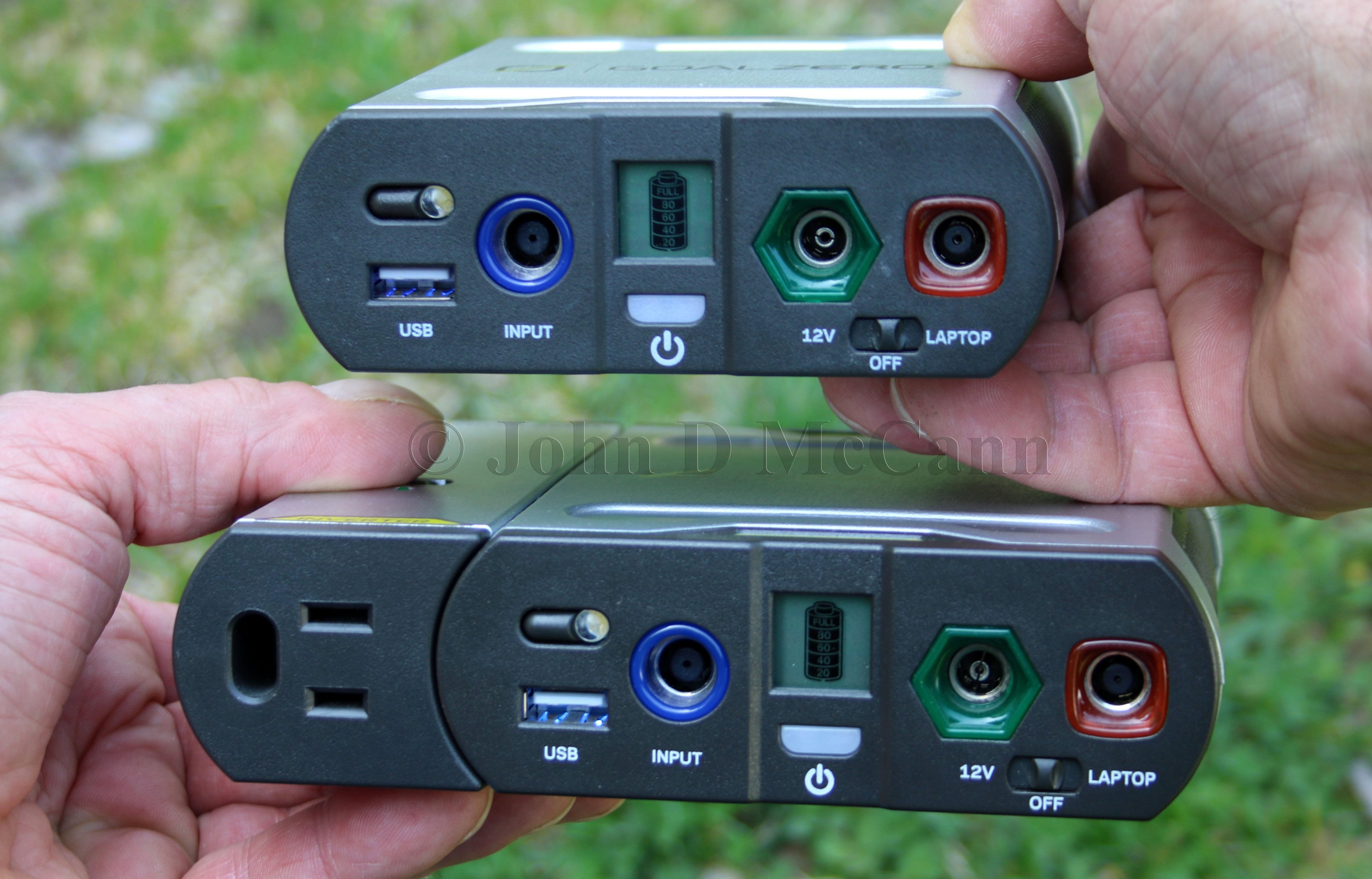 This shows the front panel of the Sherpa 50 Recharger with its various inputs and outputs. The top shows
This shows the front panel of the Sherpa 50 Recharger with its various inputs and outputs. The top shows
it without the AC inverter and the bottom with the AC inverter attached.
The Nomad 13 Monocrystalline Solar Panel pairs well with the Sherpa 50 and allows you to charge devices directly from the panel via the 5 volt USB output, the 12 volt output, or recharge the Sherpa 50 Power Pack, as well as a Guide 10 Plus Recharger, if you have one. There is a zippered pouch on the back of the panel with a junction box and cables, as well as plenty of room to store other items. It will charge a Guide 10 Plus in 2.5-5 hours and a Sherpa 50 in 6-16 hours. The panel can be chained with other GoalZero panels for additional power.
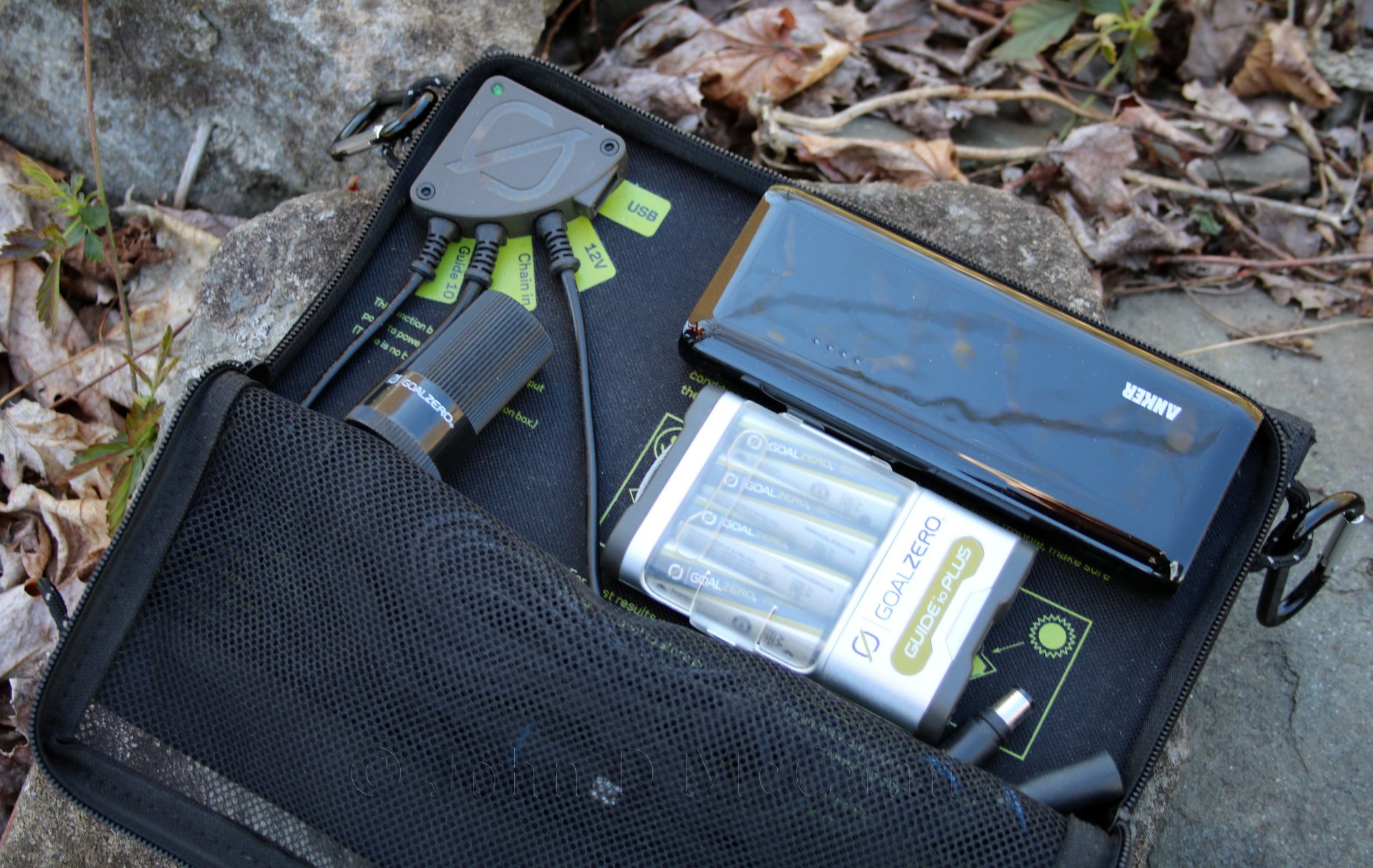 A view of the rear zippered pouch on the Nomad 13 with both the Guide 10 Plus and Anker 2nd Gen E4 Charger.
A view of the rear zippered pouch on the Nomad 13 with both the Guide 10 Plus and Anker 2nd Gen E4 Charger.
The array of outputs can be seen at the top left of the photo. The Sherpa 50 can also be carried in the zippered pouch.
I often use just the Nomad 13 on the back of my pack for charging the Guide 10 plus and other rechargers, or to directly charge my phone while hiking or sitting at camp.
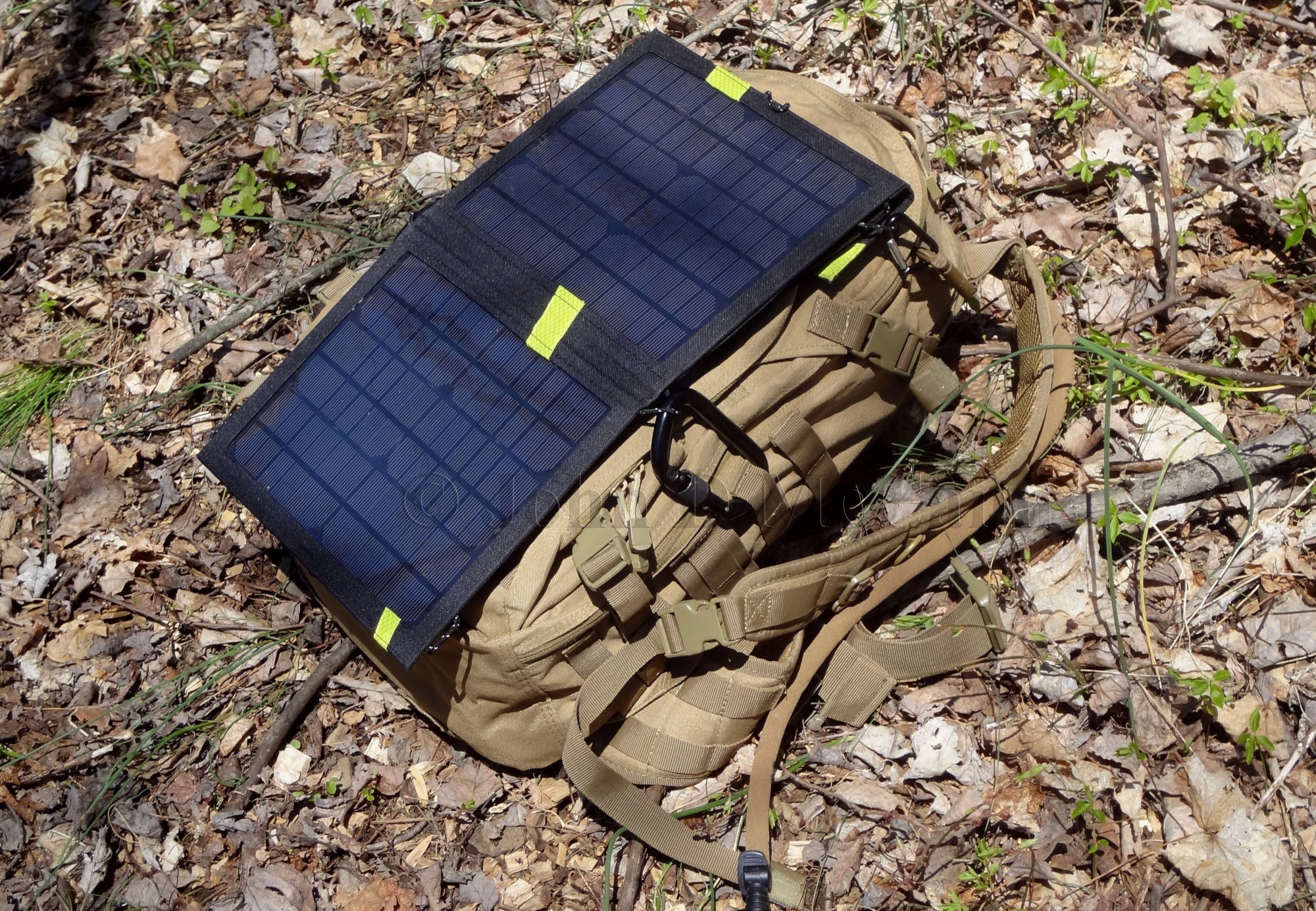 This shows the Nomad 13 solar panel attached to the back of my pack with carabiners.
This shows the Nomad 13 solar panel attached to the back of my pack with carabiners.
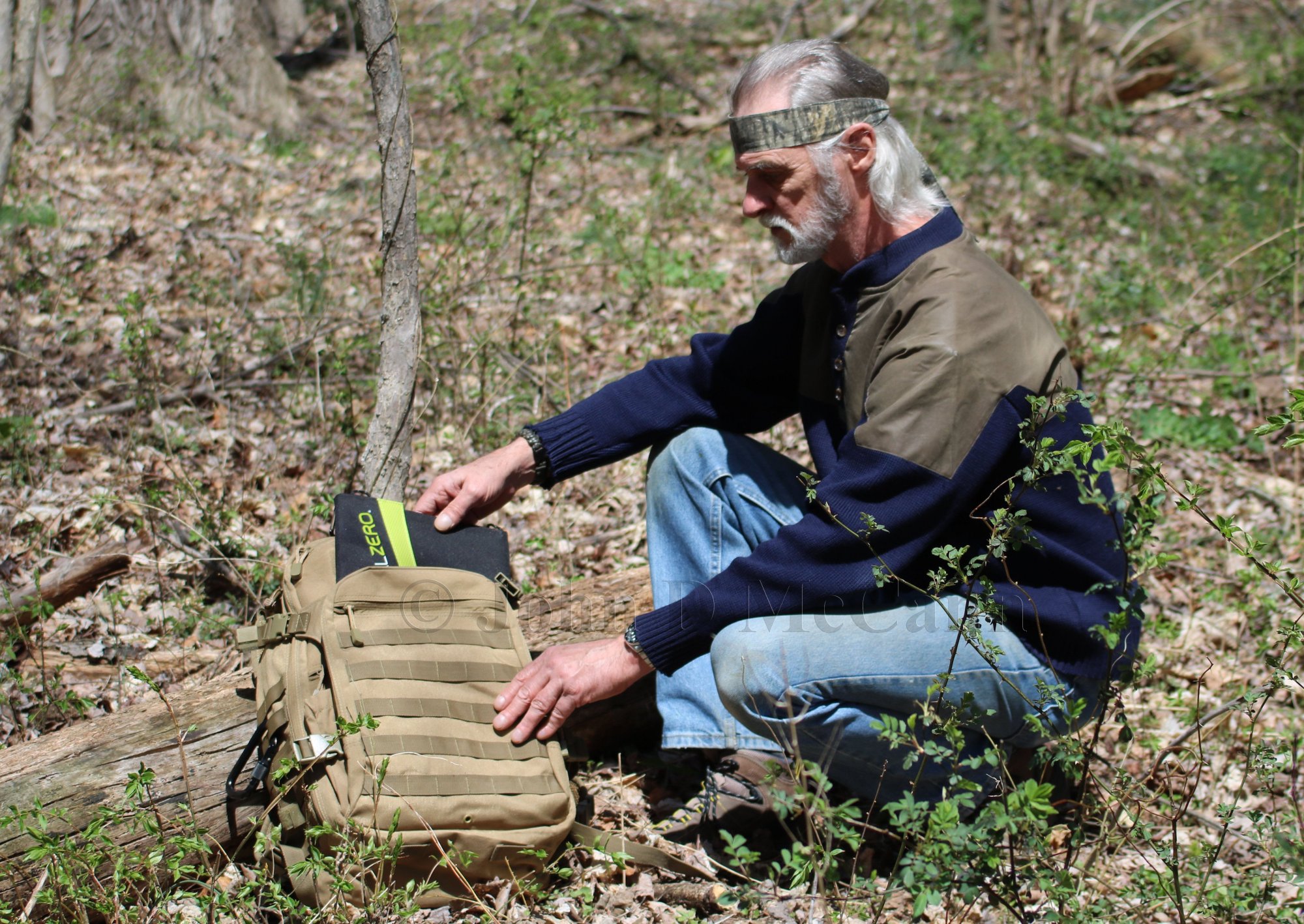 This shows me storing the Nomad 13 in the expandable stash pocket on the back of the pack when not in use.
This shows me storing the Nomad 13 in the expandable stash pocket on the back of the pack when not in use.
GoalZero offers various other sized portable solar panels which can be chained together for additional power. They can be included in various kits, depending on the room you have available. Of course there are various other manufacturers that make decent portable solar panels but I have been satisfied with GoalZero and like the fact that all of their panels can be chained together for more power options.
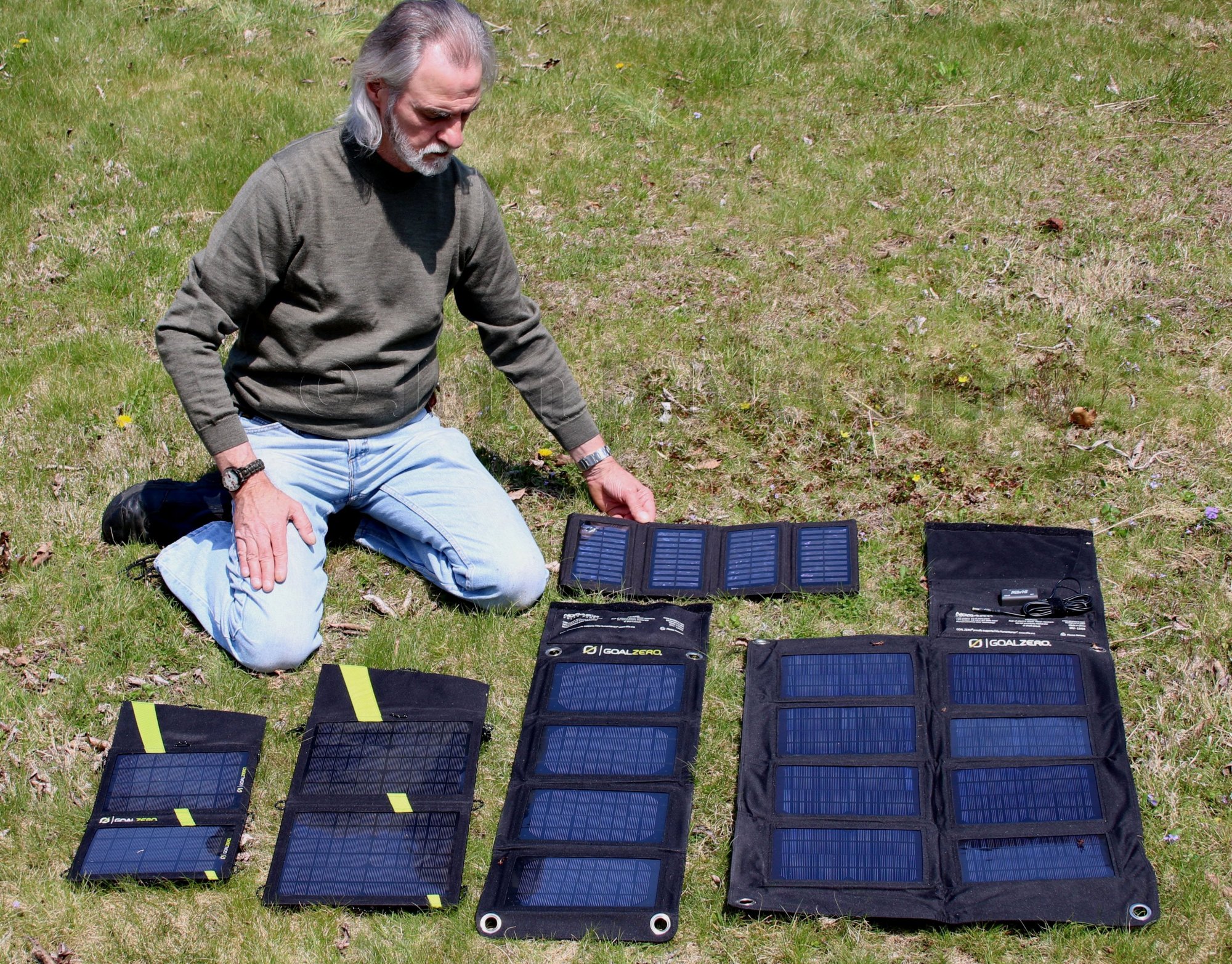 This shows me with various sized portable solar panels that I use for different situations.
This shows me with various sized portable solar panels that I use for different situations.
One thing people often forget as part of their recharging kits are the various cables and adapters which provide you with options for charging different type devices. If you package them properly they can fit into a small bag to be included in your kit.
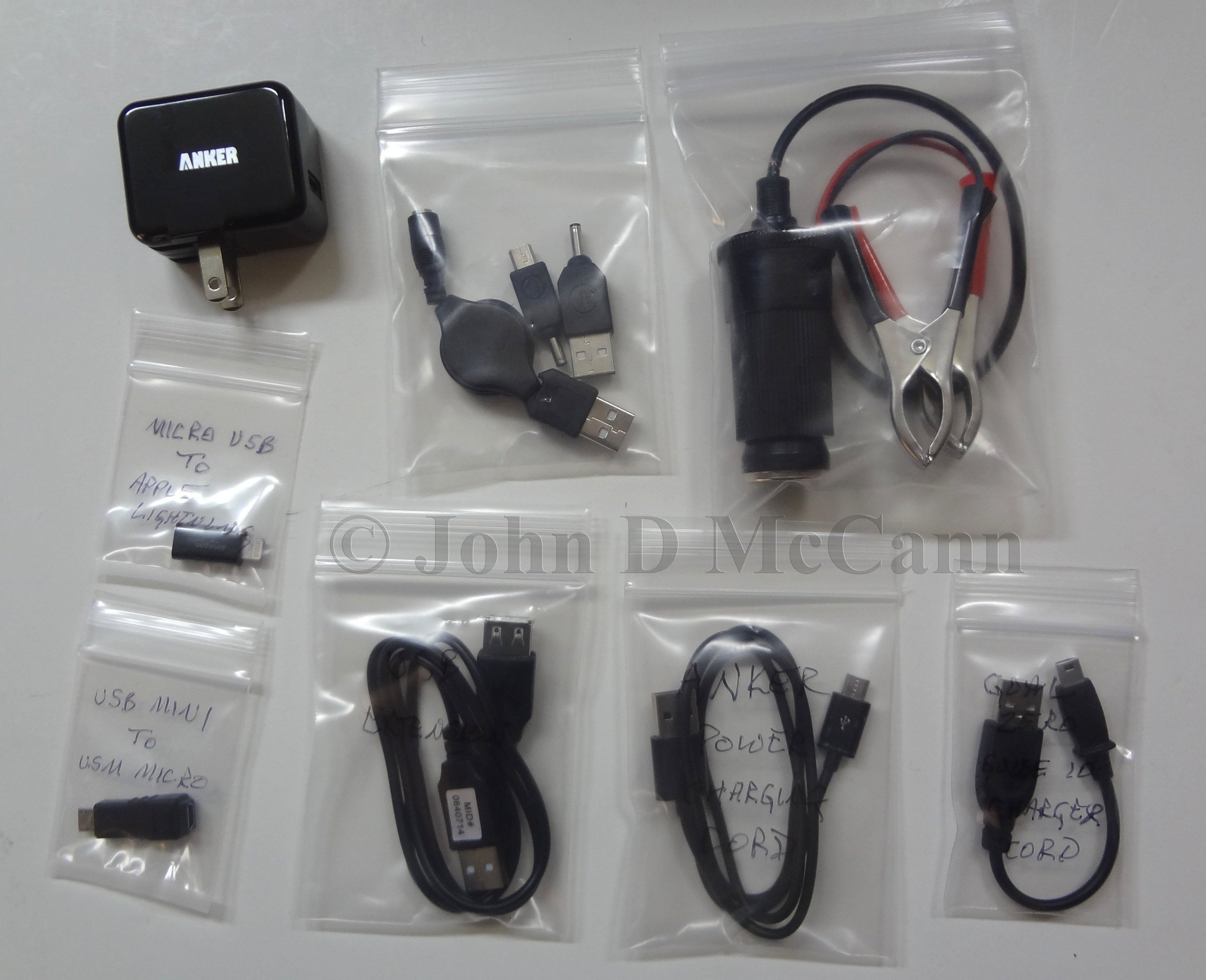 This is a view of the various cables and adapters that I carry in a small bag.
This is a view of the various cables and adapters that I carry in a small bag.
Last, but not least, you may be bugging in during an emergency situation. Of course all of the above devices and techniques can be used. Power supplies can be recharged with a generator if you have one. I have a Portable power pack which I always keep in my truck for jumping my vehicle or for additional 12V power when camping. It can also be used in the house when the power is out to recharge various devices.
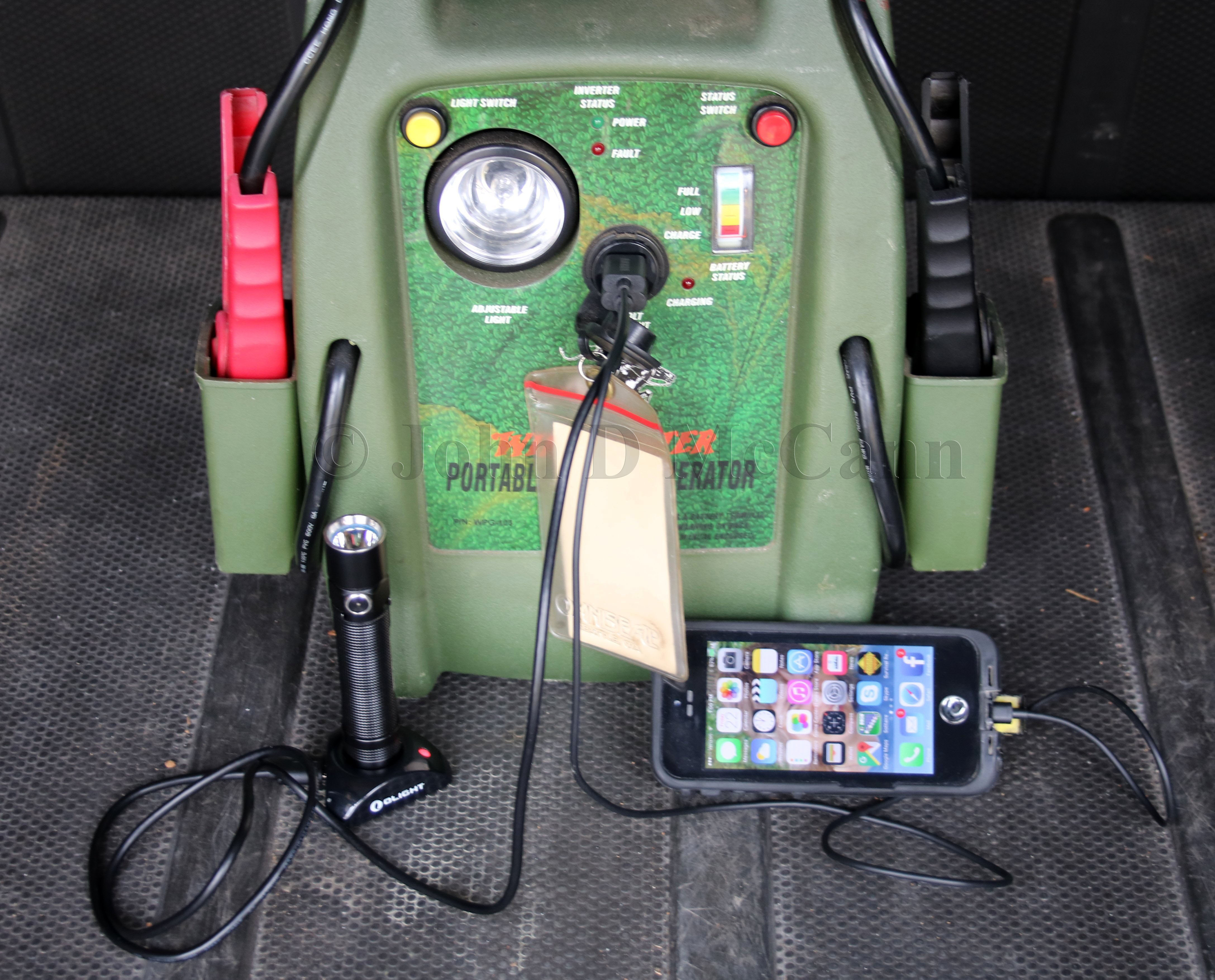 While camping, using a dual USB adapter, I charge both my iPhone and Olight S20R Baton flashlight, in the
While camping, using a dual USB adapter, I charge both my iPhone and Olight S20R Baton flashlight, in the
back of my truck using the portable 12 volt power pack, which is stored in my vehicle.
If you have other types of 12V batteries at home, like those used for an alarm system, or those being charged by solar panels, they can be used with a 12 Volt outlet with alligator clips and a 12 Volt adapter. This can provide you another resource for recharging.
As you can see, there are many ways you can recharge your various electronic devices when on the go, or even when at home without power. There are various sized devices which should allow you to find a recharging option that fits your needs and the size of your kit. Take a look around and find something that works for you.
We hope you enjoyed this article and will help support our efforts by checking out our products. As always, Be Prepared To Survive!
Copyright © 2015 by John D. McCann


